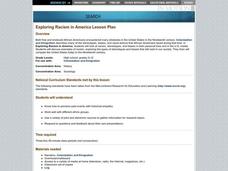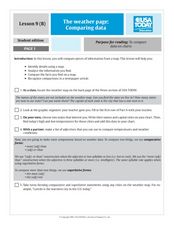Curated OER
Past School Practices
Students research the history of a school system. In this school system lesson, students list the grade levels and subjects taught in their school and interview their teachers and administrators. Students collect past photographs of...
Curated OER
Exploring Racism in America
Students compare racism today to racism that existed during the nineteenth century. As a field research project, students individually keep track of examples of racism, biases, and stereotypes illustrated throughout the US media over a...
Curated OER
Tuning the Violin
Students identify whether their A string is flat or sharp in comparison to a given pitch. Then they use their fine tuners to adjust their A string to a given pitch. Students also use the computer software program Aurelia to practice...
Curated OER
Apples
Students are asked what kinds of vegetables do they like to eat, and what kinds of fruits do they like to eat? They are asked to describe how an apple might taste. Students count the number of green apples, they are told the different...
Curated OER
The Great Depression: Eating on a Shoestring
Middle schoolers explore the realities of feeding a family on a very limited budget by comparing the cost of living in the 1930s to the cost of living today. Using primary documents and technology to make the comparison, they identify...
Curated OER
The Weather Page-Comparing Data
Students examine weather patterns in the United States. In this weather lesson, students use a United States map to identify high and low temperatures in two states. Students compare the data and record their findings onto a chart.
Curated OER
Cloze Instruction And Herringbone Technique
Students sort out important information and create a visual framework for reviewing in the future. They organize a large quantity of information thus helping with learning and remembering details, cause and effect, comparison and...
Curated OER
Abraham Lincoln Lesson Plans
This article illustrates diverse ways to educate high school students about Lincoln, his struggles and what they mean for us today.
Curated OER
The Weather Page: Comparing Data
Students recognize the different types of data on the weather page of USA Today. In this weather lesson, students compare weather data comparative and superlative forms of adjectives. Students locate 10 pieces of information in the data...
Curated OER
The Adventures of Tom Sawyer: Parenting and Discipline
Students discuss discipline in The Adventures of Tom Sawyer and compare it to how children are disciplined today. In this comparisons lesson, students identify different ways parents discipline their children. Students identify...
Curated OER
Immigration Unit
Third graders develop an appreciate for the various cultures that are present in their local community. Through reading and research, they explain how various culture came to live in their area. At the conclusion of the unit, 3rd...
Curated OER
Can We Be Both Conservationists and Consumers?
High schoolers explore their role as consumers and conservationists and what roles they play in today's economic climate. They explore resource allocation issues. Students analyze data and draw comparisons between historical and...
Curated OER
India And Pakistan At 60
Students engage in a lesson that is concerned with the comparison of India and Pakistan. They construct a venn diagram comparing the two while conducting research. There are several extension activities that include a timeline, visual...
Curated OER
The Republic; Roman History, Democracy
Students explain the ways in which current American system of government both resembles and differs from the system of government in Rome form about 510 to 264 B.C.
Curated OER
Energy of the Future
Learners examine technologies that already exist and record their findings in a journal. They work with students in other countries to explore alternative energy sources They publish their designs online.
Curated OER
Girl Power
Seventh graders explore the role of women. They contrast their empowerment from Confederation until 1920. They compare that to the role and empowerment of women in today's society through their own experiences, media, and music.
Curated OER
Baby Boom and the Culture of the 1950's
Students study the ripple effect of the baby boom generation on history and on their lives today. They discover how the rules and conformity of the 1950's set the stage for the rebellious, anti-establishment sixties. They study the...
Curated OER
Weapons of World War I
Ninth graders discover the weapons of World War I. They compare and contrast the weapons used during that time period with the weapons that are used in warfare today. They create a digital slide show with the history, uses, and...
Curated OER
Familia Romana
Students compare and contrast ancient family life to present day family life. In this Roman family life lesson plan, students discuss the roles present in their families and then learn about family life in ancient Rome. Students...
Curated OER
Treaties
Sixth graders research treaties. In this treaties lesson plan, 6th graders go online to build knowledge about treaties. Students read information and take quizzes. Students write a comparative essay about how the Aboriginal and...
Curated OER
Freedom, Rights, and Responsibilities
Students look at the primary sources that emerged from the Exodus (the Ten Commandments) and the War of Independence (the Declaration of Independence) and examine how each attempts to construct a free society and a definition of freedom....
Curated OER
Quiz 9A: Using "But"
In this comparisons instructional activity, students compete 10 sentences by using adjectives to describe two unlike things. Students then complete 8 sentences with the appropriate verb, affirmative or negative.
Curated OER
4-4-3-2 Food Counts
Students investigate the quantities of those foods they must eat each day in order to have a balanced diet. They determine the quantities from each food group they need to eat for a balanced diet.
Curated OER
Acids, Bases, and pH
Students investigate acids, bases,and pH. They test the acidity and basicity of various household items using litmus paper. Using their results, they rank the substances according to pH and identify the contributing chemical on the label.

























